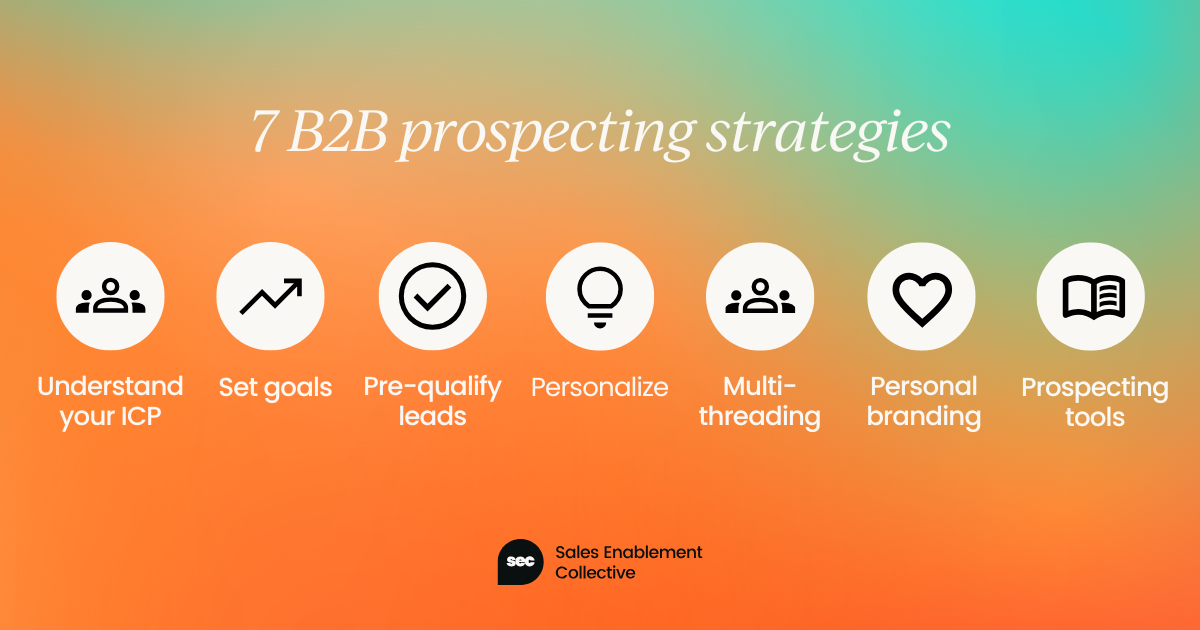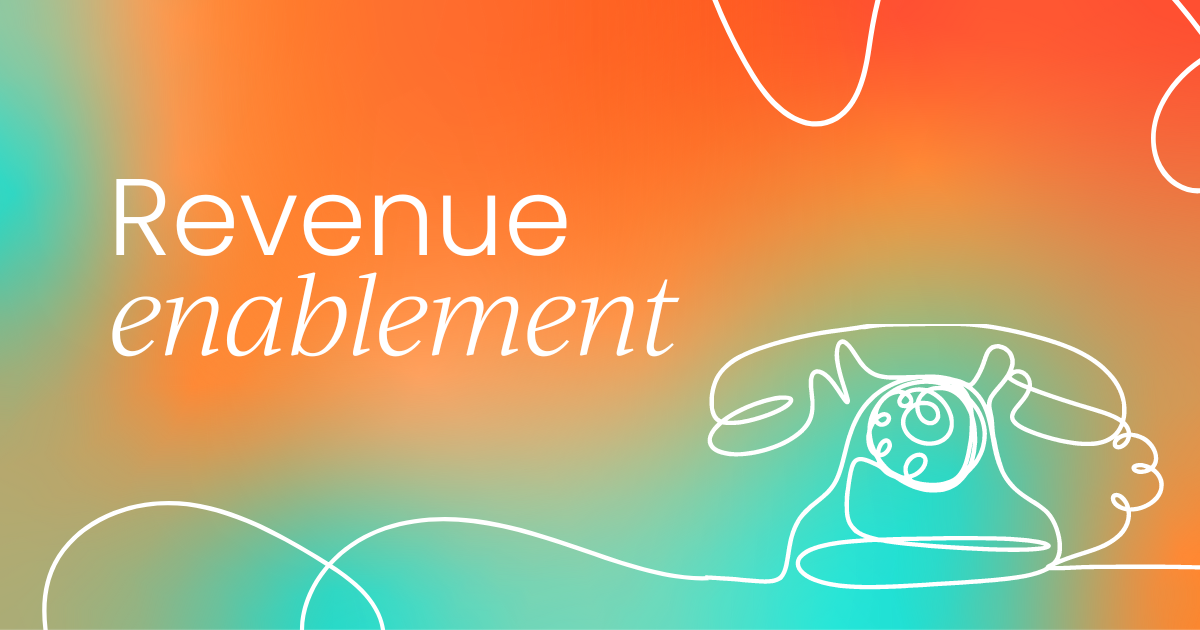What is B2B sales prospecting?
B2B sales prospecting is the process of identifying potential customers and getting them into the sales funnel.
In other words, it’s an active way of finding potential buyers, and bringing your product to them. The goal is to get those prospects into the sales pipeline, and nurture them all the way to the close.
To do this, your sales reps need to:
- Identify a set of prospects
- Make contact with those prospects
- Introduce those prospects to your products or services in an appealing way.
If they can do this successfully, they’ll have brought new deals into the sales pipeline.
Two types of B2B sales prospecting

- Inbound prospecting
This is perhaps the more obvious type. Inbound prospecting is where reps reach out to those who’ve previously shown interest in your company and your products. That “interest” might be something as small as having visited your website, or having followed you on social media. Or, they could have raised their hand more firmly, by downloading a lead magnet, or signing up to a mailing list.
- Outbound prospecting
Outbound prospecting is completely cold. These prospects haven’t shown any interest in your business or products. So what makes them prospects? They’ll have shown interest in similar products, perhaps your competitors’, or hang out in the same places your target audience does. They might follow the same businesses, people, or topics on social media, for example.
Qualifying leads means prioritization
Not all leads are created equal. The best leads will have a higher probability of converting into paying customers, and grouping your prospects according to their probability of converting is a best practice.
Qualifying the lead is a crucial step in the prospecting process. Ramming through a list of names, numbers, or email addresses top-to-bottom is certainly one way of doing it, but it’s not the most certain to net a good return on time invested.
Inbound prospecting should usually take priority over outbound, since these leads have explicitly shown interest in your business. More importantly, though, the best prospects will be those that most closely match your ICP (ideal customer profile).

Why is B2B sales prospecting important?
Okay – before we move on, let’s think about why it’s important that reps prospect for leads.
While some product-led organizations believe that a revolutionary product will market and sell itself via word of mouth, most businesses don’t have a product that’ll change the world. They have a product that’ll improve the daily lives of those occupying a particular niche.
These businesses need to invest in marketing and sales strategies to get and stay ahead.
But without prospecting, you’re relying on customers coming to you and making the first move.
They might discover you through your advertising and marketing efforts, but it often pays to take matters into your own hands by making the first move. Especially if yours is a high-ticket product with a price tag that’s likely to put many off.
No, to get prospects that fit your ICP to see that your product is a great fit for them, you sometimes need to engage them in conversation and show them. Without a serious B2B sales prospecting strategy, you risk losing a large portion of potential buyers to more aggressive competitors.
Here are some of the benefits of a dedicated B2B sales prospecting strategy:
- Ensures a consistent sales pipeline.
- Helps to accelerate the sales cycle.
- Leads to better communication between sales and marketing.
- Results in higher-quality leads.
- Drives more revenue.

7 B2B prospecting strategies
Okay – now that we understand what B2B prospecting is and why it’s important, let’s take a look at how to do it with seven B2B prospecting techniques.

1. Understand your Ideal Customer Profile (ICP) inside and out
As we’ve established, there’s an opportunity cost associated with reaching out to the wrong people.
Your prospect list needs to be as strong as possible. A great way to get started with this is to use a resource other teams in your organization have probably already created: your ICP.
If you don’t have an ICP defined already, get some help from your marketing team, or follow these steps:
- Define the type of business you're most interested in selling to, including their needs, interests, budget, and market position.
- Look at elements like company size, industry, geography, and legality.
- Develop buyer personas, which are models of the specific contacts you're trying to connect with, including their roles, responsibilities, and motivations.
- Understand their pain points and buying triggers.
This works, quite simply, because you’re listing all the attributes of those who are most likely to be interested in (and buy) your products or services.
Reps can then make sure they’re reaching out to those who match the ICP first, ensuring they get the greatest ROI possible on their outreach efforts.
2. Set prospecting goals
As an enabler, you can use prospecting to extract better results from your sales reps.
You encourage them to start at the beginning, and to work on strengthening their lead lists, which should make their outreach (and selling attempts) more effective.
To measure success with this as a method, though, you need to set goals.
Consider goals like hours spent prospecting, LinkedIn connection approvals, number of meetings booked, target revenue, churn rate reduction, and new customer gains per geographic zone.
These are all measurable and quantifiable. They’ll help you and your reps gamify the prospecting process, which can prove key for keeping motivation high.
3. Pre-qualifying leads
Again, time spent chasing the wrong leads is time poorly spent.
The more your reps can pre-qualify leads, before they even get on the phone with them, the better the results you’ll get.
In practice, this takes the form of filtering out those leads who don’t fit your ICP. That means considering things like company size, growth stage, and industry.
But also encourage your reps to think about things like:
- Are they likely to have the budget to pay for your solution?
- Are they likely to be actively looking for an alternative solution?
- Are there signs that their current solution isn’t working for them?
If your lead list is small, this becomes less important. But when you’ve got a long list of potential leads, you only want to engage with the strongest set. That’s when it’s time to aggressively cut out the least likely leads. Pre-qualification is a strong solution to that problem.
4. Next-level personalization
It’s tempting to automate outreach. It’s one of those repetitive, dull tasks that can feel unrewarding.
But full-scale automation here is rarely the right approach. The risks for getting it wrong are too great (because when you get it wrong, you get it wrong at scale, and do massive damage to brand trust, reputation, and any previously established rapport).
When reps take the time to truly personalize their outreach messaging, however, they take on no such risk, and they’ll see their response rates skyrocket.
Encourage them to always make their outreach specific, relevant, and personalized. This will strengthen the emotional connection.
Here are some tips:
- Speak to prospective customers like you’re talking to a friend.
- Research potential connection points such as mutual connections or trigger events to personalize outreach.
- Reference something specific about the prospect’s company or role in cold emails.
5. Multi-threading with stakeholders
Ensure your reps remember that the opportunities they’re chasing are with businesses, rather than with individuals.
Sure, they’re trying to establish human connections with individuals, but while one person proves unresponsive, someone else in the company might be more open to a conversation.
Therefore, it pays for reps to build relationships with as many stakeholders as possible within a target company.
Encourage them to reach out to more than one decision-maker at a time. This helps navigate complex sales processes and increases the chances of success.

6. Leverage a personal brand
Reps can differentiate themselves (and, by extension, your org) by building credibility on the social platforms your customers use.
As an enabler, you can help them here. Give them the materials they need to fully understand the pain points your customers feel, and to write about them confidently. Alternatively, take the work off their hands and outsource it to your marketing or content team. Have someone from one of these teams ghostwrite the material for them.
No matter how you get it done, sharing thought leadership insights positions your reps as industry experts. Ones who understand the problems your customers face, and can be trusted to fix them.
When your reps do finally reach out, they’ll already have a strong reputation in the eyes of those who fit your ICP.
7. Use a prospecting tool
Leverage sales tools to help with the heavy lifting of finding contact information and automating outreach.
While you shouldn’t completely automate the prospecting process, you can and should leverage technology to help you:
- Find more opportunities, and more quickly.
- Automate parts of the process that don’t involve customer interactions.
- Synthesize information from disparate sources to give reps the best info available about a potential prospect, faster than they could research it themselves.
Utilize tools for data and prospecting insights, sales enablement, social selling, lead management, and lead scoring. All-in-one B2B prospecting tools are a good call. They’ll offer instant access to accurate contact information and outreach workflows, drastically speeding up the prospecting process, and helping your reps make qualify and call more leads.

9 B2B prospecting methods
1. Cold calling
The method sales reps love to hate.
There’s no way around it. Cold calling still works. It might be time-consuming, difficult, and nerve-wracking, especially for newer reps. But it’s also bold and punchy.
Cold calling often works precisely because it’s difficult. While rival firms find excuses to wind down their cold calling efforts, ramp yours up to take advantage of this tried-and-true prospecting technique.
2. Cold email outreach
Cold email outreach involves sending personalized emails to prospects you haven't previously contacted.
Remember, personalization is key for high open and response rates. To improve these metrics, consider drip campaigns, or reserving cold emails for those who’ve found their way onto a mailing list via a lead magnet, or have otherwise raised their hand in interest for your solutions previously.
3. LinkedIn prospecting and social selling
LinkedIn is a great prospecting platform. There’s plenty of publicly listed information available, like industry, company size, and job title, to help your reps filter those who do, or do not, fit your ICP.
Building out your professional network is also built into the functionality of the platform, and is actively encouraged. This gives you access to prospects you might never have found otherwise.
Reps can also seek out and post in LinkedIn groups, or use the platform to build a personal brand to build trust and rapport.
4. Being active in online forums
The above also applies to other online forums, and anywhere else where there’s a conversation happening related to the services and solutions you provide. Reddit is a great place to do industry research, but you can also take part in and trigger those conversations yourself to unearth new prospects.
5. Capitalizing on inbound marketing
Cold, outbound outreach will only get you so far. You can, and should, begin harvesting details of those who are interested in your solutions. Work cross-functionally to build valuable assets potential customers can get in exchange for their email address.
This gives them value, and a great impression of your brand, and gives you their contact details. Follow up with them about their experience with the lead magnet in question for a sensibly personalized first message.
6. Routinely asking for referrals
This one can sit with your customer success team, if you have one. But they’ll have to feed these referred leads back to you or the sales team for you to follow up with.
Feel free to own this as an enabler, though. Owning initiatives that improve the lists of prospects your sales reps have to work with is never a bad thing.
Look to obtain leads from satisfied customers, partners, or business networks. Referral leads tend to be high-quality and more open.
7. Networking events and conferences
Attend industry events to meet potential clients face-to-face and build direct connections, and then make sure to follow up with them after the event.
This is great, because it gives you the chance to make the connection (and a great first impression) in person. It can feel like the stakes are higher, but that’s exactly why this works. Others are less likely to go to this extent.
If your organization is large enough, you can even look to sponsor an existing event, or put on the entire event yourselves. The latter option gives you complete control over every aspect, including who attends, and the kind of value you’ll offer them via the event.
8. Webinars
Hosting informational webinars is a great way to attract qualified prospects interested in a specific topic related to their pain points.
Team up with an industry expert to offer cutting-edge info that’s hard to get anywhere else. Choose topics that speak to the most specific, current, and agonizing pain points your prospects are feeling right now. This will get them signing up in droves, giving you the chance to follow up with them after the event.
Most webinar platforms also give you engagement data, giving your reps the chance to pre-qualify the list according to the most engaged contacts.
9. Direct physical mail
Physical mail isn’t dead, it’s a differentiator.
Getting a care package in the mail is always a wonderful surprise these days because it’s so rare. Our electronic mailboxes are spilling over with unread fluff that draws on our time. We spend our days glued to screens. Getting pulled back to the real world with a message you can actually hold in your hands makes you stand out.
This is particularly effective when combined with other methods, as it adds a personal touch for top prospects.

Essential tools and tech for B2B prospecting
If you’ve the budget for it, build out a small prospecting tech stack. It’ll help you scale your prospecting efforts and improve the quality of your leads at scale.
Below, we’ve listed categories of tools in priority order, starting with the most important.
Lead intelligence and contact discovery
First off, tools that help your reps find and qualify leads, through information about them and the organizations they work for, take priority in a prospecting tech stack.
Example tools
- LinkedIn sales navigator
- Apollo.io
- ZoomInfo
- Lusha
2) CRM Platforms
Once you have a list of prospects, you need to be able to track those leads, and their status.
Have you reached out already? Have they expressed interest?
Keeping contacts organized is the bread and butter of the CRM. This a very mature category, with lots of powerful options to choose from, and automation functionality built in.
Example tools
- HubSpot Sales Hub
- Pipedrive
- Salesforce Sales Cloud
3) Cold outreach automation
If you decide to go the automation route, then cold outreach automation and sales engagement tools like those listed below will help you scale your efforts.
Remind your reps of the importance of personalization, and of the risks of getting things wrong at scale.
Example tools
- Salesloft
- Outreach.io
- Lemlist
- Mailshake
4) Social selling and personal brand-building platforms
Building trust and visibility on a platform like LinkedIn can help build trust in your sales reps and in your brand. This can help with conversion rates, but it’s a long-term game to play. It’s not a quick win.
Social selling platforms (especially LinkedIn) are great resources for discovering prospects, but those are largely covered by the lead intelligence and contact discovery tools that form the base of your tech stack pyramid.
Example tools
- Hootsuite
- Buffer
- Shield
- Taplio
5) Email marketing and lead nurturing tools
Tools in this category are more reliant on inbound leads. Marketing-qualified leads who raise their hands in interest by downloading a lead magnet, or signing up for a webinar, for example.
These are less important for the bulk of your prospecting, but are essential for nurturing leads who might not be ready to buy yet, or for reaching out to leads in a more indirect fashion.
Example tools
- ActiveCampaign
- MailerLite
- ConvertKit
Looking for next steps?
10,000+ sales enablers from all over the world trust SEC to be the go-to resource for their learning and development. Benefit from our community-led resources through the insider plan, for free!
- Templates and frameworks: Save time with battle-tested and ready-to-use templates. 📖
- SEC-GPT: Solve challenges with the cumulative knowledge of our community. 🤖
- Real-world case studies: Hours of insights from leaders at Uber, Oracle, Adobe, and more. 🗣️
- Industry insights: Ungated access to first-hand research from thousands of sales enablers in our annual Salary and Landscape Report. 📈
- Supportive community: Join our global community of sales enablers whom you can bounce ideas around with and get support from other like-minded professionals. 🤝
Accelerate your career without spending a dime.
Become an SEC insider now. 👇



Sales enablement insider
Thank you for subscribing
Level up your sales enablement career & network with sales enablement experts
An email has been successfully sent to confirm your subscription.


.png)







